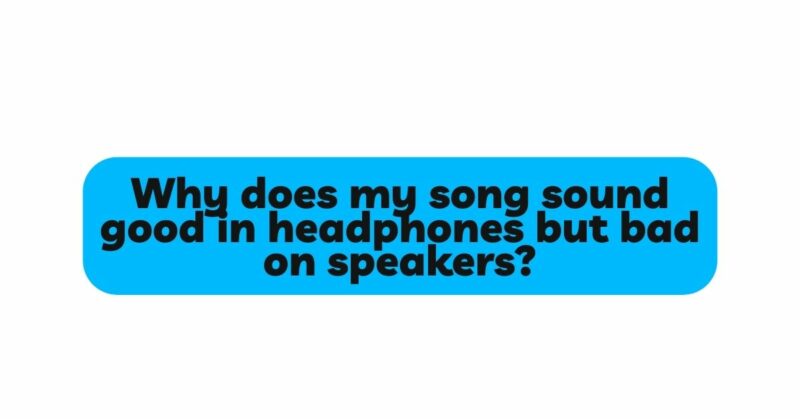It’s a common frustration among music creators and listeners alike: a song that sounds impressive and well-balanced when played through headphones suddenly loses its charm and clarity when played on speakers. This phenomenon can be perplexing, but understanding the underlying reasons can help us make informed decisions during the music production process. In this article, we will explore the factors that contribute to the disparity in sound quality between headphones and speakers, shedding light on the unique characteristics of each playback system and offering practical tips to bridge the gap.
- Individual Acoustic Properties:
a. Headphones: When listening through headphones, sound is directed straight into the ears, creating an intimate and direct listening experience. The close proximity of the drivers to the ears ensures that details, nuances, and stereo imaging are more pronounced, resulting in a heightened perception of clarity and separation.
b. Speakers: Speakers interact with the room acoustics, producing sound waves that bounce off walls, ceilings, and furniture before reaching the listener’s ears. This interaction can cause reflections, standing waves, and other acoustic phenomena that impact the overall sound quality and clarity.
- Frequency Response and Sound Coloration:
a. Headphones: Headphones typically have a more consistent and accurate frequency response compared to speakers. This means that the frequency balance and tonal characteristics of the audio signal are faithfully reproduced, resulting in a more detailed and precise sound representation.
b. Speakers: Speaker systems, especially those not designed for studio monitoring, may introduce coloration or irregularities in the frequency response. This can result in an uneven tonal balance, where certain frequencies are accentuated or attenuated, leading to a different sonic character compared to the original mix.
- Stereo Imaging and Soundstage:
a. Headphones: Headphones offer an immersive and intimate listening experience with precise stereo imaging. The audio signal is presented directly to each ear, allowing for accurate localization of instruments and sound sources within the stereo field. This can create a wide and detailed soundstage that is often perceived as more pronounced and focused.
b. Speakers: Speakers provide a more room-filling sound experience, with sound waves interacting and reflecting within the listening environment. The stereo imaging and soundstage may be broader but can be influenced by the room’s acoustics, speaker placement, and listener’s position, resulting in variations in the perceived spatial positioning of instruments and sound sources.
- Bass Response and Low-Frequency Perception:
a. Headphones: Headphones provide a more controlled and direct bass response due to the close proximity of the drivers to the ears. This can result in a more pronounced and detailed low-frequency representation, allowing listeners to perceive subtle bass nuances and textures.
b. Speakers: The bass response of speakers can be influenced by the room’s dimensions, furniture placement, and speaker positioning. These factors can lead to room modes and standing waves that affect the perceived bass reproduction. Additionally, the interaction between the speaker and the room can cause bass to be less defined and more diffuse compared to headphones.
- Mixing and Production Considerations:
a. Speaker-Monitoring Approach: Given the potential disparities between headphones and speakers, it is essential to adopt a balanced approach to mixing and production. While headphones can provide a detailed representation of individual elements, it is crucial to periodically check the mix on different speaker systems to ensure its compatibility and translation across various playback environments.
b. Room Treatment: Taking steps to improve the room acoustics, such as adding acoustic treatment panels, bass traps, and diffusers, can help minimize the negative impact of room reflections and standing waves on the sound quality. This can enhance the accuracy and consistency of the audio reproduction on speakers.
c. Reference Tracks: Using well-produced reference tracks that are familiar and have a balanced sound across different playback systems can serve as a benchmark during the mixing and mastering stages. Comparing the mix to reference tracks on both headphones and speakers can help identify potential issues and guide the necessary adjustments.
d. Skill and Experience: Developing a keen ear and familiarity with the strengths and limitations of different playback systems takes time and experience. As you gain more knowledge and hone your listening skills, you’ll become better equipped to make informed decisions regarding the mix and ensure that it translates well across various listening environments.
Conclusion:
The discrepancy in sound quality between headphones and speakers is a result of the distinct characteristics and limitations of each playback system. Headphones provide an intimate and focused listening experience, emphasizing detail, stereo imaging, and frequency accuracy. On the other hand, speakers interact with the room acoustics, offering a more room-filling sound but introducing potential coloration and variations in frequency response. Understanding these differences is crucial for music creators and listeners alike. By adopting a balanced mixing approach, considering room treatment, using reference tracks, and developing a keen ear, it is possible to bridge the gap between headphone and speaker listening experiences. The goal is to create mixes that sound good and translate well across a variety of playback systems, ensuring that your music is enjoyed in its intended form regardless of the listening environment.


